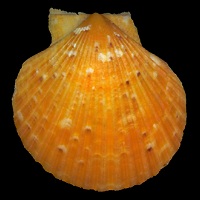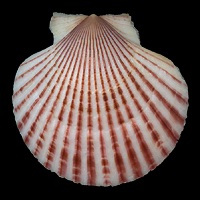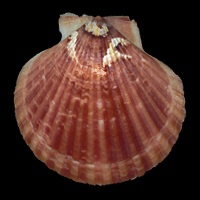Four distinct populations of
Aequipecten opercularis (Linnaeus, 1758) in Brittany



The well known Aequipecten opercularis is a medium sized shell, usually measuring 50 to 55mm width, very few specimens reaching to the 60-70mm. Larger specimens do exist but, due to overfishing, become extremely rare. It is a common scallop, ranging from Norway to Mediterranean sea, Lofoten to Canaries. Fished for consumption, the species has declined in the 20 past years but seems now rising again.
Each winter, this shellfish is sold in huge quantities on the fishmarkets of Brittany.
One of the best places to sample many specimens coming from various localities of the province is the fishmarket of Rennes, where many areas are represented, from St-Brieuc to Cancale, Lorient to Le Croisic.
Each winter, this shellfish is sold in huge quantities on the fishmarkets of Brittany.
One of the best places to sample many specimens coming from various localities of the province is the fishmarket of Rennes, where many areas are represented, from St-Brieuc to Cancale, Lorient to Le Croisic.
Variations:
I retained three easily identifiable forms, towards which all my collected shells tend.
lineata (da Costa, 1778): pale shell with a dark maroon line on each rib of the top valve.
concolor (Bucquoy, Dautzenberg & Dollfus, 1889): unique colour.
maculata (Locard, 1888): with a mottled or marbled pattern.
The two first forms are well known, and invade the collections.
Three shelling areas, four collecting spots:
The first zone which produces many of the opercularis sold on the fishmarket is located near the Loire estuary, off Le Croisic (map, area #1). These shells are collected by scallop trawlers which fish the Pecten maximus. Sandy bottoms.
The second zone is located in the southern waters, east of Quiberon Peninsula, near the shore. The shells collected here are juvenile specimens, attached by their byssus to other collectible species (wild Crassostrea gigas, Chlamys varia). The boats which dredge this population look after the "deep water oysters" which inhabit muddy stone & gravel bottoms, at depths ranging between 10 to 20m (map, area #2).
The last zone is the Bay of the Mt Saint-Michel, on the north-eastern end of Brittany. The shells are collected by Pecten trawlers (map, area #3).
Two distinct populations, coming from this last area, are sold on the fishmarket.
A first one lives on muddy bottoms, and is dredged by some boats of Cancale harbour, on the western side of the bay. The second population is dredged on sandy bottoms in the eastern side of the bay, and will be called "Saint-James", which is the name of the place where these shells are sorted.
Therefore, to summarize, we can look closely four different populations, which have rather different conditions of existence:
1- "Le Croisic" offshore on sand, out of the sedimentary plume of the Loire river;
2- "Quiberon" near the coast, on mud and gravel amidst mussels and oysters;
3- "Saint-James" offshore on sand, in the sedimentary plumes of the eastern rivers;
4- "Cancale" offshore on mud and gravel, in clear water.
The second zone is located in the southern waters, east of Quiberon Peninsula, near the shore. The shells collected here are juvenile specimens, attached by their byssus to other collectible species (wild Crassostrea gigas, Chlamys varia). The boats which dredge this population look after the "deep water oysters" which inhabit muddy stone & gravel bottoms, at depths ranging between 10 to 20m (map, area #2).
The last zone is the Bay of the Mt Saint-Michel, on the north-eastern end of Brittany. The shells are collected by Pecten trawlers (map, area #3).
Two distinct populations, coming from this last area, are sold on the fishmarket.
A first one lives on muddy bottoms, and is dredged by some boats of Cancale harbour, on the western side of the bay. The second population is dredged on sandy bottoms in the eastern side of the bay, and will be called "Saint-James", which is the name of the place where these shells are sorted.
Therefore, to summarize, we can look closely four different populations, which have rather different conditions of existence:
1- "Le Croisic" offshore on sand, out of the sedimentary plume of the Loire river;
2- "Quiberon" near the coast, on mud and gravel amidst mussels and oysters;
3- "Saint-James" offshore on sand, in the sedimentary plumes of the eastern rivers;
4- "Cancale" offshore on mud and gravel, in clear water.